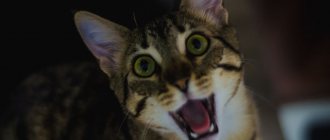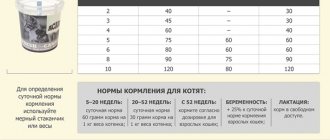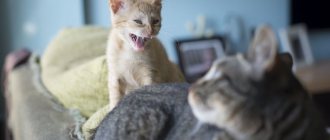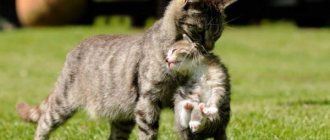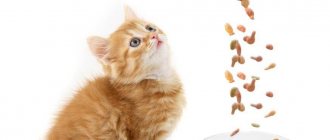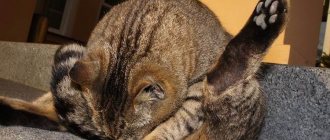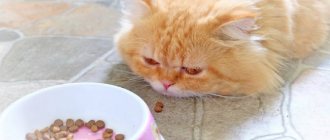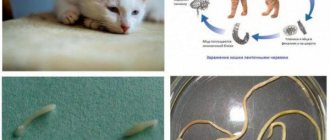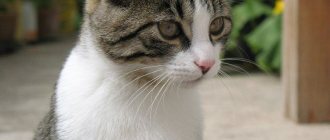October 25, 2018
If a kitten refuses dry food, then very rarely the problem is in the diet itself. Of course, cats have their own taste preferences, and they eat some foods more readily than others, but the reasons why a kitten does not eat dry food are most often of a completely different nature. These are exactly what we will look at in this article, and then we will move on to practical questions: what to do if the kitten does not eat dry food.
Appetite decreases due to stress
The first thing new owners do is feed their pet. Having brought the kitten home, they pour him a whole bowl of food and expect him to immediately empty it. But at this time the baby is experiencing extreme stress: separation from his mother, moving to a new home, a complete change of environment. No wonder he has no time for food.
Take your time with feeding. Let the kitten explore the territory, come to terms with the separation, and get used to new people. If there are other animals in the house, keep them in another room for now. After an hour or an hour and a half, you can offer dry food: most likely, by this time the new pet will have worked up an appetite and will eat more willingly.
Reasons for refusing dry food
When you notice your mustachioed pet's dissatisfaction, pay attention to specific behavior. Partial refusal to eat, not accompanied by other alarming symptoms, may be temporary.
If the volume in the bowl does not decrease, and the cat experiences severe weakness and apathy, contact your veterinarian. Poor appetite is one of the symptoms of many dangerous diseases. Do not ignore this point, citing the usual pickiness.
Problems with smell
Unlike human receptors, cats are less developed. They perceive taste less well, so when choosing food, cats are repelled by its smell. If you have problems with your sense of smell, even your favorite treats lose their attractiveness.
Poor appetite due to heat, heat, or illness
Another reason for poor appetite is hot weather. At high temperatures, not only humans, but also pets lose interest in food. If your pet lies down most of the time and drinks water heavily, just wait until it gets colder.
The problem can also occur during estrus. The period of sexual heat takes a lot of energy from the pet, so the entire body concentrates on the instinct of reproduction. Other needs are temporarily ignored. Here it is important to observe the absence of other alarming symptoms, since in this case refusal to eat can be interpreted as a sign of pathology.
In case of serious illnesses, there is not just a partial, but a complete refusal to eat. It may be accompanied by fever, gastrointestinal upset and severe weakness. If the sick animal also refuses water, make an appointment at the veterinary clinic as soon as possible. Prolonged dehydration (more than 12-24 hours) can be fatal.
Stress or regime failure
A cat may refuse food due to extreme stress. This often happens when moving, renovating, or adding a new family member.
If your mustachioed pet happily eats handouts and refuses basic food, think about the feeding regime. The lack of a strict schedule and frequent feedings are fraught with overeating and pickiness. By the time of feeding, the cat simply does not have time to get hungry or deliberately ignores the food in the hope of begging for something more tasty.
Rejection of pellets as food
If you have just recently switched your pet to dry feeding after natural feeding, just give him time. The rejection is explained by the less pronounced smell and taste characteristic of ordinary products.
If the cat has been drying for more than a year, check the condition of the teeth. If you have problems with the oral cavity, chewing on hard particles is very painful. In this case, the animal will regularly visit the kitchen and ask for food.
Unsuitable product
This problem often occurs when switching to a higher grade food. Budget brands contain dangerous flavor enhancers and flavorings, while expensive brands contain only natural ingredients.
After poor-quality feeding, the animal needs time to get used to the new diet. In this case, it will be similar to a person trying to switch to a healthy lifestyle after eating fast food for a long time.
Also, the cause of deterioration in appetite may be dissatisfaction with a too monotonous menu. In this case, the diet should be slightly adjusted by adding wet canned food or replacing the existing “crackers” with a different brand.
Damaged product
The taste of ready-made cat food can be ruined not only by the expired expiration date, but also by improper storage. Once the package is opened, the contents quickly oxidize, becoming rancid. Such a product can cause poisoning, so the animal will instinctively refuse it.
Dirty bowl or feeding area
Whiskered pets are very clean. They will not eat from a dirty bowl or eat near their toilet.
In addition to dirt and location, you should consider the material used. Cheap plastic quickly absorbs foreign odors, so the contents of the bowl become unpleasant for the animal. Also, water from a nearby bowl can get into the crackers, turning them into a soggy mess.
No habit of dry food
If your kitten has never tried dry food before, he will probably be suspicious of such food. Wet food from bags and natural food smell more intensely in comparison with dry granules, which predetermines the pet's preferences. Soaking with warm water can be a way out. This way the granules acquire a more pronounced meat aroma and a consistency familiar to the baby.
If this does not help, you can initially mix dry food with wet food, increasing the proportion of the former every day. Normally, such a transition takes 5–10 days. During the soaking and mixing period, the kitten will have to be fed frequently (5-6 times a day), offering a fresh portion each time. As soon as he begins to consume dry food, you can pour granules twice a day - morning and evening. The baby will come to the feeder when he is hungry, even if he is left alone at home.
Important rules for transferring a pet to dry food from other types of food
When switching a cat to another type of food, you must follow several important rules:
- Taking into account the needs of the pet. The cat's preferences should be taken into account before offering another food. If your pet is a big fan of chicken, then it is unlikely that he will eat meat crackers. But indicating the type of meat on the package is not an advertising ploy, as many people think. A self-respecting manufacturer provides truthful information, which cannot be said about budget food. They use flavorings that are identical to natural ones. In addition, high-class industrial food is initially designed for the specific needs of the pet: to facilitate the removal of hairballs, for sterilized cats, for active cats. You should immediately take these nuances into account so that your pet receives a diet that suits its needs.
- Gradual means a gentle introduction of industrial feed into the diet. A sudden change is harmful and even destructive. It is enough to replace 1/10 of the usual portion with “crackers” and increase it daily by 1/10.
Every day you should replace only 1/10 of your pet’s usual diet with dry food.
- Time. The transfer from one type of feed to another should be carried out within 10–14 days. During this time, the cat will already taste new food. After this time, only the industrial product should be in the bowl.
- Unobstructed access to water. This is the most important rule when feeding commercial food.
The nuances of switching to dry food from different diets
Depending on what the cat ate previously, there are some nuances when switching it to dry food.
From wet industrial food
If the cat ate canned food, that is, wet industrial food, then everything is simple. In the first 2-3 days, crackers must be pre-soaked to the desired consistency. Gradually, soaking can be replaced with light moistening with the sauce from these canned foods. That is, mix the granules into a bowl, let it brew, and then offer it to the cat. At the last step, you can simply stir in either just the sauce or just the pieces. And after complete adaptation, leave only dry food.
From natural homemade food
The same rule applies here as with wet food. But cats are very suspicious animals and can easily recognize deception. Experts recommend starting with mixing canned food into natural food, and only then switching from wet industrial food to dry food. By the way, it will take the same amount of time: about two weeks.
There is another, simpler way: offer a dry food pellet as a treat. And specifically for a hungry pet. If no problems arise, then pour the food into the bowl during feeding hours.
My mother decided to switch her cat to dry food. I bought him a pack of Royal Canin. But the pet did not appreciate the taste or smell of the new food at all - he simply buried it with his paw, twitched his tail and walked away. Mom tried to soak it and mix it in, but the cat had no intention of even trying the new treat. Then they bought him a banal “Friskies”. It was he who ate him by both cheeks. But, of course, you can’t feed an animal with this product all the time. The next experiment was with Purina Van food. It fit perfectly too. And finally, the final product in this chain was Purina ProPlan food. Both the owner and the pet settled on it; it suits them in all respects. So if your cat refuses dry food, he may simply not like the taste or smell of this product. And never buy large packs of expensive food at once - there is a chance that you will have to feed it to street cats.
In case of partial replacement of other feeds with dry food
Many cats are not particularly mischievous and happily eat both wet and dry food. This is quite normal, especially if there is only one manufacturer. As a rule, problems with replacement do not arise here. The owner should only strictly decide at what hours he feeds dry food and at what hours he feeds wet food.
Bad food
When an animal does not eat dry food well, sometimes the reason lies in the quality of the product itself. Perhaps it is not tasty enough or spoiled. Cats are obligate carnivores and are most attracted to meat, so it is important to choose food with a high content of it. Acana and Orijen diets consist of 75–85% meat ingredients and other animal products (fish, eggs, innards). This is an excellent choice both for raising kittens and for maintaining the body of an adult cat.
Don't forget that even the highest quality food can be spoiled if it is expired or stored incorrectly. Cats, like other animals, have an innate ability to distinguish healthy and safe food from harmful and inedible food. If the fats in the food have oxidized, a person may not feel it, but the kitten will not eat such food, and rightly so. The owner will have to purchase fresh packaging of food and store it properly in the future.
The cat refuses to eat
An alarming situation arises when a cat suddenly stops eating familiar food and does not even respond to treats. This may happen for the following reasons:
- Diseases - from toothache and intestinal infections to pancreatitis and kidney failure.
- Medical procedures - loss of appetite is considered one of the side effects of vaccination, and after operations using anesthesia, the cat may not eat for up to two days.
- Changing the situation - rearranging furniture, repairs, moving, traveling. In the last two cases, the cat may also feel sick from motion sickness in a car or plane.
- Psychological problems - stress, lack of attention, conflicts with family members and other pets.
What to do. Consult your veterinarian as soon as you notice changes in your cat's eating habits. The faster you respond to a problem, the greater the chances of a favorable resolution.
Food vagaries
Little kittens evoke affection and a desire to care. Everyone around is trying to treat them with something tasty, without thinking about the consequences. In fact, such “care” backfires on both the owners and the animal:
- the baby develops the habit of begging;
- food whims arise: the kitten does not eat dry food well, because it hopes for something “yummy”;
- nutrition is not balanced, which negatively affects the development of a growing body.
During the period of accustoming to dry food, it is recommended to exclude all treats and treats. Warn all family members about this so that they do not inadvertently violate your plan.
Why doesn't an adult cat eat dry food?
There are several main reasons for refusing dry food:
1. Habit. If a cat lives with a person, it gets used to the latter’s lifestyle and diet. Such habits are difficult to eradicate because they begin to work at the level of reflexes.
2. Wrong smell. Often, cats don't like a certain type of food simply because it doesn't smell like natural food. If, for example, a cat is accustomed to catching mice or eating meat from the owner’s table, then after sniffing the food, she will understand that it is a completely different product and will begin to refuse.
3. Consistency and temperature. These two parameters are very important for a cat. And if he doesn’t like the food to be cold or too large, the cat will refuse to eat it.
Health problems
Sometimes owners' concerns about their pet's poor appetite are justified. We are talking about illnesses and problems with well-being. If a kitten that is already accustomed to dry food suddenly begins to eat poorly, you should be wary. Other symptoms may be observed: fever, lethargy, apathy, diarrhea or vomiting. Then you need to contact your veterinarian and follow his recommendations.
Situations are especially alarming when the animal does not drink and loses interest not only in dry food, but in general in any food, including its favorite treats.
Determining the causes
Start by studying the composition of the food your pet refused. Read reviews about this manufacturer. Pay attention to whether there are cases of allergic reactions, whether problems with the gastrointestinal tract of animals have been recorded.
If the manufacturer is popular among cat owners, then analyze the shelf life of the product and its storage conditions. Quite often, whimsical kittens refuse the product because it is not fresh. Food that has not been stored properly can absorb foreign odors that can overpower your favorite flavors.
Keep an eye on the cups where the food is placed. Cats and cats are clean animals. Leftovers from previous meals can completely kill your appetite. And the absence of a cup of clean water next to a cup filled with food can turn the pet around for the purpose of self-preservation. Drinking is important for health, don't forget about it.
If the baby is very small, then refusing to eat may mean a simple inability to cope independently without the help of a cat. Lack of experience in eating, no matter dry or wet food, can lead to constant refusals. Then the pet should be helped and taught to eat on its own.
In fact, the kitten eats not so bad
Often, owners only think that the animal is not eating enough. In reality, the whole point is that the baby’s needs are small. Calculate the daily feeding amount for your pet and see if he eats it. For Acana and Orijen feeds, the daily dosages are as follows:
- 60 grams per 1 kg of weight when the kitten has not yet reached the age of 20 weeks;
- 30 grams per 1 kg of weight - after 20 weeks (during this period, kittens no longer grow so intensively).
Upon reaching 12 months, the cat is considered an adult and should eat in accordance with the general norm.
Unsuitable cookware
Cats are very clean animals, so they can be capricious when it comes to food if the “dining room” does not meet their requirements. Your pet may refuse food if:
- Food is served from a plastic bowl. As you know, plastic has a very unpleasant chemical smell, clearly distinguishable by the delicate animal sense of smell. In addition, plastic can react chemically with food ingredients. In connection with the above, it is recommended to buy metal or porcelain bowls for pets.
- The plate is poorly washed or contains dried remnants of the previous dinner. Animal hygiene rules should not be blatantly ignored.
- Cat dishes are washed using household chemicals, which leave a lasting scent trail. Immediately after eating, it is enough to rinse the bowl under running warm water.
- The food bowl is placed in an inappropriate place, such as close to a tray of sand or running water. Cats instinctively separate the “dining room” and the “toilet”, taking care of the cleanliness of food and water.
- The food container is excessively narrow and deep, and therefore has an unpleasant effect on the cat’s whiskers. It has been proven that the whiskers of animals perform the function of touch, “feeling” the surrounding space. They allow the cat not to make a mistake with the diameter of the hole through which the animal can crawl. If the sensitive “antennas” rest against a hard surface, the cat feels discomfort and immediately retreats. This is exactly what happens when your mustache touches the sides of an incorrectly selected bowl. Felinologists recommend feeding cats from a wide, flat plate.
Read the article:
- Is it possible to feed a kitten only wet food?
- how and when to switch a kitten to dry food;
- What is the difference between kitten food and adult food?
Listening to the animal's opinion
It is very important to observe how the animal reacts to different types of food. If the kitten does not want to eat dry food, then natural food is preferable to him: dairy and meat products that you yourself eat.
The body of an animal, especially a kitten, is very sensitive. As long as it is not contaminated with various harmful additives, it is able to determine which foods are good for it and which will harm it. Therefore, you should not punish a kitten for its reluctance to consume something that, in its opinion, is harmful.
The one who always ate does not eat
It is not surprising if a cat refuses to eat dry food, which he always ate with pleasure. This happens often, but it does not mean that something happened to the animal. Perhaps I'm just tired of the smell and taste. It's time to find a worthy replacement for your usual food. You don’t have to look for an analogue; you can try a completely different type of nutrition. Let’s say if you constantly used dry food “Friscas with vegetables”, then what’s stopping you from offering a piece of liver or chicken fillet? It is possible that the cat will be delighted with such a treat.
The same applies to kittens. You need to try everything, but do not overfeed with different foods. This is necessary in order to understand what the animal’s preferences are: natural food or food industry products.
Attention to pet health
When introducing a new food, dry type, you should be attentive to how your pet feels. You should monitor what kind of feces the animal has, and whether there are any impurities in the urine. Complications that may occur include constipation and indigestion.
If such complications are detected, you need to stop introducing new food and show the cat to a veterinarian. It will be possible to resume feeding with ready-made food no earlier than after five to six weeks.
You will need to try another brand of food, but it must be high-quality and from a reputable manufacturer.
What to do
From the very first days of a kitten’s stay in the house, you need to decide what will be more convenient to feed it. If the choice falls on dry food, you need to accustom it to it from an early age. When exactly, you should consult a veterinarian.
If it is not possible to give your pet good premium and super-premium food, then it is better to feed your pet natural food:
- What is the difference between the feeds? Warnings regarding inexpensive feeds have good reason. They consist mainly of cereals, meat, and there are practically no high-quality offal in them. A caring owner will not feed such food to a small kitten, risking its health and even life. Economy class food should only be used as a last resort.
- The premium food group is more suitable for the diet of small kittens. Many manufacturers producing this product also include kitten food in their series. The food already contains more meat and less grains.
- The best option is super-premium ready-made food . Its components are only natural, there are no flavors or dyes.
If you can't spend a lot of money on super premium, you need to find a good premium brand. It is important to combine dry food with canned food. How to properly feed a kitten from the first months of its life can be found out from the veterinarian who is observing the pet.
Manufacturers indicate on the packaging the recommended serving for kittens of a given age; you should definitely follow these recommendations. If overfed, the kitten will quickly recover, but obesity can lead to serious illnesses.
Dry food is usually introduced into the diet at six weeks of age. But it’s better to wait until six months or a year. The period of getting used to such food will take some time, you need to be consistent and not rush. Dry food becomes complementary food, a supplement to milk. The addiction should become gradual.
IMPORTANT! You cannot suddenly change the nutritional system of not only a small kitten, but also an adult.
If a cat owner treats this issue irresponsibly, this can lead to big problems for the animal’s health. At best - diarrhea, vomiting, constipation. The digestive system can be seriously damaged and treatment will be necessary.
When purchasing a kitten from a breeder, owners usually receive a pet that is already accustomed to a certain type of food. You should find out the brand in order to give the animal the same food, at least for the first time.
